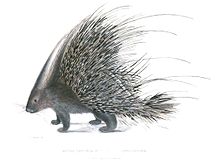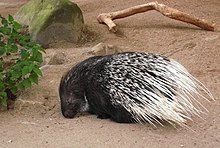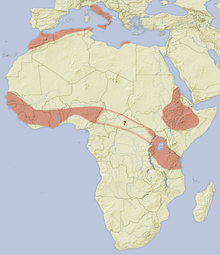Crested porcupine
This article needs additional citations for verification. (April 2009) |
| Crested porcupine | |
|---|---|

| |

| |
| Crested porcupine in captivity | |
| Scientific classification | |
| Domain: | Eukaryota |
| Kingdom: | Animalia |
| Phylum: | Chordata |
| Class: | Mammalia |
| Order: | Rodentia |
| Family: | Hystricidae |
| Genus: | Hystrix |
| Species: | H. cristata
|
| Binomial name | |
| Hystrix cristata | |

| |
range
| |

The crested porcupine (Hystrix cristata), also known as the African crested porcupine, is a species of
Characteristics
The adult crested porcupine has an average head and body length around 60 to 83 cm (24 to 33 in) long, discounting the tail, and weighs from 13 to 27 kg (29 to 60 lb). It is one of the largest rodents in the world.[3]
Almost the entire body is covered with bristles which are either dark brown or black and rather coarse. This mammal is recognizable by the quills that run along the head, nape, and back that can be raised into a crest, hence the name crested porcupine. Also, some sturdier quills which are about 35 cm (14 in) in length run along the sides and back half of the body. These sturdier quills are used, for the most part, for defense and are usually marked with light and dark bands which alternate; these are not firmly attached. This porcupine has a short tail which has rattle quills at the end. The rattle quills broaden at the terminal end and the broad portion is hollow with thin walls. When these quills are vibrated, they produce a hiss-like rattle.
The front feet of the crested porcupine have four developed and
Crested porcupines live up to 28 years, the second-longest of any rodent after the naked mole-rat, which can live in excess of 37 years.[6][7]
Distribution and habitat
The crested porcupine is found in Italy, North Africa, and sub-Saharan Africa. In the Mediterranean, it is known from mainland Italy and the island of Sicily, Morocco, Algeria, and Tunisia; they are also recorded in Ghana, Libya and along the Egyptian coast. It has been recorded from sea level to 2,550 m (8,370 ft) in Moroccan Anti-Atlas.


The crested porcupine is native to
Behaviour and ecology
The crested porcupine is a terrestrial mammal; it very seldom climbs trees, but can swim. It is
Crested porcupines have been known to collect thousands of bones that they find at night. They are mostly nocturnal, and they may come upon the
Diet and digestion
The crested porcupine is for the most part
Reproduction
Most of what is known about reproduction in the crested porcupine comes from individuals in captivity. Usually, female crested porcupines have one
Local and indigenous names
- In Italian: porcospino or istrice
- In the Tigrinya language: ቅንፈዝ (qinfiz)[8]
- In Amharic: jart
- In the Akan language: kotoko
- In the Oromo language: xadddee
References
- ^ . Retrieved 19 November 2021.
- OCLC 62265494.
- ISBN 978-0-87196-871-5.
- ^ a b c McPhee, M. (2003). "Hystrix cristata". Animal Diversity Web.
- .
- ISSN 0065-2598.
- PMID 29364116.
- ^ ISBN 978-3-030-04954-6.
- S2CID 130452325.
- PMID 32704027.
- .



